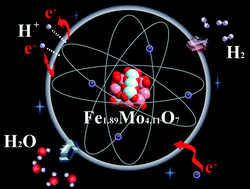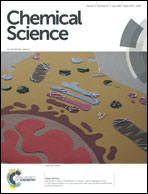A bimetallic oxide Fe1.89Mo4.11O7 electrocatalyst with highly efficient hydrogen evolution reaction activity in alkaline and acidic media†
Abstract
Transition-metal Mo-based materials have been considered to be among the most effective hydrogen evolution reaction (HER) electrocatalysts. Regulating the electronic structure of Mo atoms with guest metal atoms is considered as one of the important strategies to improve their HER activity. However, introduction of guest metal elements in the vicinity of Mo sites with atomic-level hybridization is difficult to realize, resulting in the failure of the modified electronic structure of Mo sites. Herein, an Fe1.89Mo4.11O7/MoO2 material is prepared through the thermal treatment of a ferrimolybdate precursor. It exhibits a Tafel slope of 79 mV dec−1 and an exchange current density of 0.069 mA cm−2 in 1 M KOH medium, as well as a Tafel slope of 47 mV dec−1 and an exchange current density of 0.072 mA cm−2 in 0.5 M H2SO4 medium. Compared to original Mo-based oxides, Fe1.89Mo4.11O7 with the regulated Mo electronic structure shows a more suitable Mo–H bond strength for the fast kinetics of the HER process. Density functional theory (DFT) calculations also indicate that the Mo–H bond strength in Fe1.89Mo4.11O7 is similar to the Pt–H bond strength, resulting in the high kinetic activity of Mo-based HER electrocatalysts in alkaline and acidic media.



 Please wait while we load your content...
Please wait while we load your content...